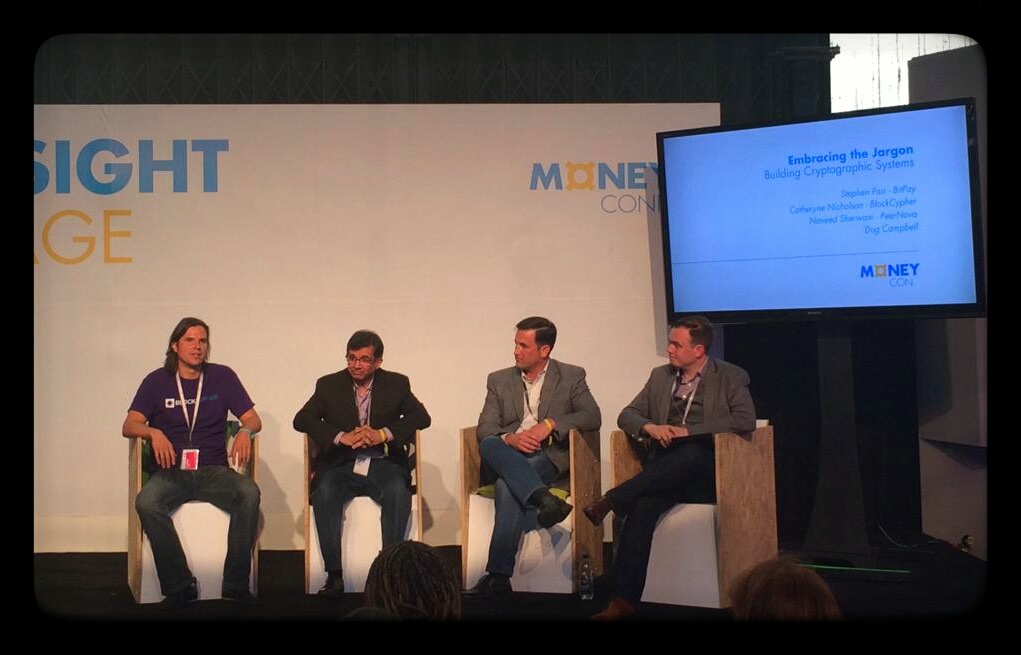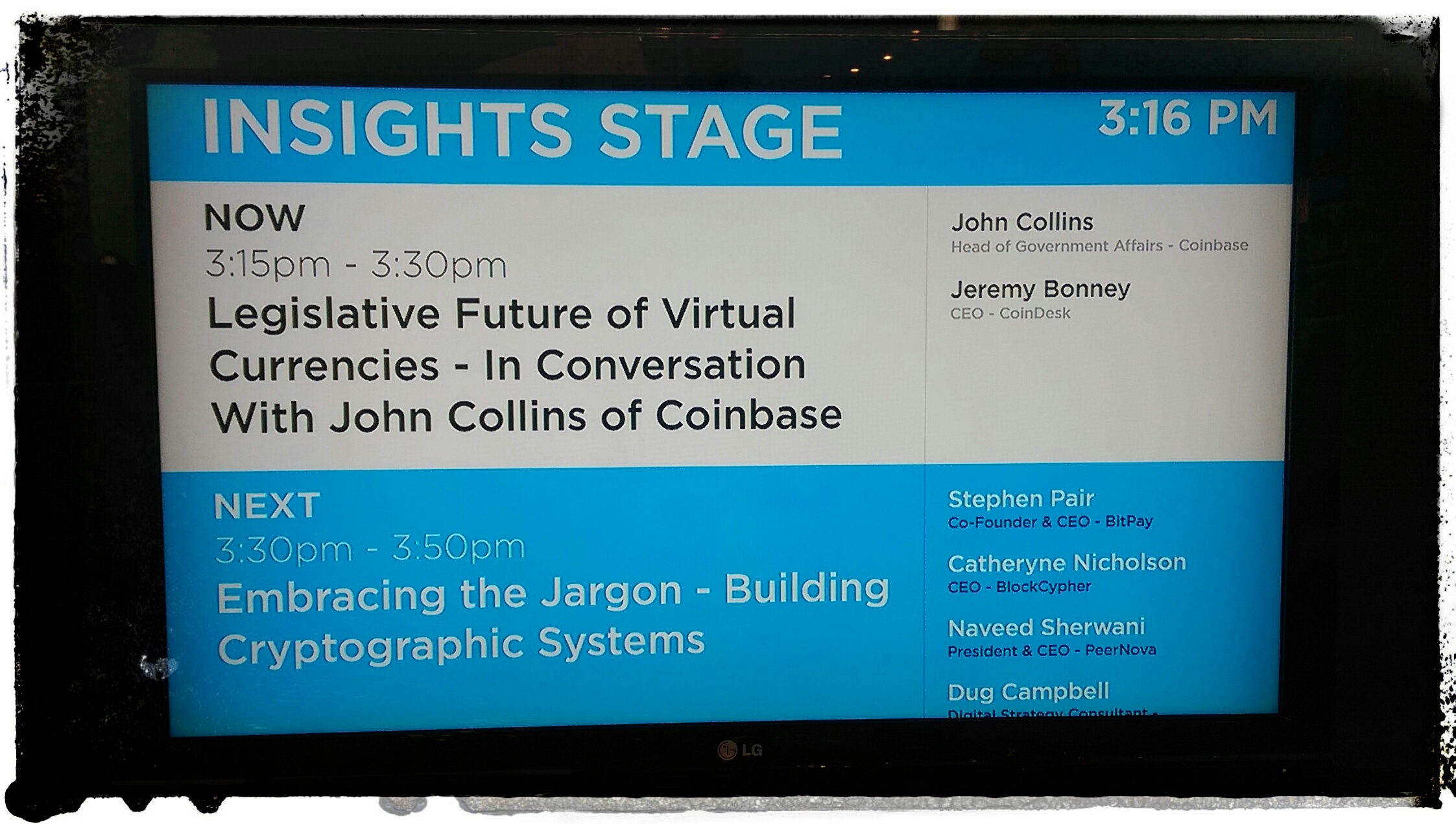“blockchain technology…is presented as a piece of innovation on a par with the introduction of limited liability for corporations, or private property rights, or the internet itself” (The Economist)
Over recent months, we’ve seen a number of recurring themes in the Bitcoin community. Whilst the heated block size debate appears high up on that list, I wanted to touch on another key narrative that’s continuing to provoke much discussion.
Driven by rising interest levels within the mainstream financial services industry, the issue revolves around a deceptively simple question.
Can We Have Blockchains without Bitcoin?
I’ve had a number of conversations recently within traditional financial services organisations who are starting to explore the potential of blockchain technology. But one thing is clear. Whilst the technology is becoming increasingly attractive to them, Bitcoin itself is still sometimes seen as a weird crypto-anarchic-libertarian concept that must first be set aside in order to let the real work commence.
Now for those who understand Bitcoin in depth, this is surely a deeply flawed concept. When it comes to the blockchain and Bitcoin, each needs the other for survival right? And any attempt to split the two will kill the value of both.
But innovation should be welcomed in whatever form it takes – whether incremental or ‘Big Bang’ disruptive. Whilst the second option is clearly more attractive, I’d argue smaller steps are still worth taking when the true enemy is actually the status quo. The value of innovation is often subjective in any event, viewed differently according to each person’s unique mix of perspective and timescale.
So, to draw a parallel from my past life, a law firm that develops automated document assembly plans for the future will be dismissed without a second thought by those who are seeking to develop smart contracts that automate those firms themselves out of existence and vice versa. But then the technologists fail to develop an understanding of the all-too-real existing constraints and the incumbents fail to set their sights high enough.
The lesson? If opposing sides simply dismiss competing arguments without taking the time to genuinely explore their merits, both risk missing out on the subtleties. So with this post, I intend to do just that. Not to provide answers per se but to collect some key arguments from both side of the debate. Of course, it’s merely scraping the surface. But it’s worth starting with an overview.
Let’s Start With The Easy Bit – A Misunderstanding
Many who repeat the “blockchain good, bitcoin bad” refrain have overlooked one key fact. Many businesses that the press are now championing as being pioneers of blockchain technology are actually reliant on Bitcoin.
Whether that’s NASDAQ’s decision to use ‘a blockchain ledger’ on its Private Market platform, the use of ‘distributed ledgers’ to streamline financial settlement by Digital Assets Holdings (check out this recent talk by the CEO, ex-JP Morgan senior exec Blythe Masters) or even Overstock’s CryptoBond, any mention of Bitcoin itself is often abstracted by the press in favour of a focus on blockchain technology.
So it’s important to remember that each of these not-insubstantial bets have been made by people and organisations who believe that Bitcoin’s blockchain will succeed (check out the diplomatically-worded blog post by Peter at CoinCenter for a similar perspective).
For the rest of this post, I’ll call the (permissionless) blockchain that underpins Bitcoin the ‘Satoshi Blockchain’ for clarity.
The Argument for No
Secure. Public. Permanent. Immutable. Massively resilient. Just a few of the features that describe the Satoshi Blockchain. Yet all of these features cannot exist without one thing: Bitcoin miners who believe that they will earn more money than they spend if they turn on their computers to take part.
Incentive is crucial to the Satoshi Blockchain. If it will cost a miner £151 to get one Bitcoin by turning on his computer to mine when he could simply buy one for £150, which option do you think he will choose?
This mechanism beautifully balanced. And the result? Take away the bitcoins and the Satoshi Blockchain can’t function.
Unless the value of bitcoins to be won by miners exceeds the money they spend in burning electricity and investing in the capital infrastructure necessary to compete for dominance in the current mining arms race, the Satoshi Blockchain would be far less secure – and all of those fascinating projects listed above would be going nowhere.
The mining game might be preparing to undergo significant change with the resolution of the current block size impasse, just as 21 turns on its mining capacity (and BitFury their lightbulbs!). But irrespective, under the current model, it’s clear that the miners need to be paid for the system to work.
So if it’s clear that those who secure the network need a financial reward, why can’t we simply pay them with fiat currency, instead of bitcoins?
For one very good reason. Do that and you destroy one of the characteristics that has enabled Bitcoin to thrive over the years.
Censorship resistance.
In other words, if you build a permissionless system (that is open to anyone to join) that requires money, it must use a native currency. You cannot use money that is issued by a third party because there is always a risk that that third party might then censor (e.g. delay or withhold) payments. Instead, the money must be created within the system itself and it must function as a bearer instrument itself (like cash) – in other words, if you hold it, it’s yours (with no third party rights cutting across the ownership).
And this is why it is impossible to separate Bitcoin from the Satoshi Blockchain. There is simply no other way to incentivise the miners. It needs native digital money that is valuable and a guarantee that this will only be distributed according to the rules of the protocol.
The Argument for Yes
So it’s agreed then. If you want to reach decentralised consensus under adversarial conditions, you need an incentive structure.
But – hold on a second. Proof of Work (a security model that intentionally makes it very expensive to attack the network because it requires miners to burn all this electricity) is surely only necessary under certain conditions.
What if you’re a financial organisation? You don’t actually want the system to be open to everyone. You want to restrict those who have the ability to update the ledger to an agreed number of known people – because if it all goes wrong, you’ve then got someone to sue. You’re perfectly happy with the security systems that you currently use within your organisation to date and provided you control the small number of people who can update the ledger, you don’t need Proof of Work to protect the integrity of the network.
And I believe that it’s here that you see the key point emerge. Bitcoin’s model works amazingly well because it is a close-to-perfect solution for people for whom the anonymous verification of transactions carried out on a P2P basis (meaning that no third party is required) is one of the key attractions.
But within financial services, a heavily-regulated sector that views anonymity as a weakness and collectively has no desire to avoid censorship by third parties, a demand for a related type of blockchain-technology with a different feature-set appears to have emerged.
Here, there’s no need for miners. Save the money and replace them with ‘permissioned’ blockchains. This simply means that those using this private blockchain can ensure that someone who wishes to update the ledger must be authorised in advance and their identity known. Suddenly we have a very different beast. Now we have a database tool that no longer needs tokens that command a market value – because they have no need to act as an incentive. And of course, it avoids any uncomfortable questions about bitcoins within an environment that demands a high level of compliance and box-ticking.
Different Use-cases – Or A Fundamentally Different Technology?
For many, this closing of the doors and restricting access goes against the very essence of the (Satoshi) Blockchain. But there seems to be a growing understanding that as the area continues to be explored, people are most likely talking about (at least) two very different concepts. There’s an argument that the term ‘blockchain’ cannot cover both concepts.
But is a permissioned blockchain not simply a database?
In some ways, yes. But this is a database on steroids. One that contains rules about who can update the ledger and how. One that gives you conclusive evidence of when the records were changed and by whom. One that can be designed to reject any types of transactions that are deemed to be unacceptable at the outset. And one that will be reconciled globally in a fraction of the time that it currently takes and therefore can be automatically audited.
When it comes to the banking industry, it’s hard to believe that back office settlement platforms won’t move soon to decentralised ledgers. Think about the current system for a minute. Currently every bank has to spend huge amounts of time recording and continually reconciling complete records of every single transaction that takes place between them. If A sends money to B, both A and B have to record that transaction in their respective books. One transaction, two records. But what if that transaction was instead recorded automatically on one single ledger?
Clearly the financial services industry will have privacy concerns.
However, as Richard Gendall Brown explains in writing about this concept that he has called the replicated, shared ledger, these should not now be an issue. The system works because there is a single record of all transactions, a copy of which (complete, updated and protected) is held by each financial institution. Each would only be allowed to update the records that relate directly to its own dealings – and so the master record is now collectively maintained by all, allowing everyone to enjoy the benefits of a system with vastly improved efficiency.
Conclusion
To me, it’s clear there is a use-case for both types – and no doubt many variations in between (and beyond). Undoubtedly permissioned block chains are a significant step forwards for the financial services industry (amongst others). However, as progressive as such a change would be, it still doesn’t provide the oxygen that is so readily available within a permissionless system such as Bitcoin to nurture the truly ground-breaking innovations.
With the evidence to date, the answer to me seems to come down to this. Large financial services will inevitably focus on incremental change – because when you’re dealing with such significant sums of money and the strictures of regulation, any improvements in efficiency, no matter how small, will have massive financial benefits. Permissioned systems will therefore fill this role successfully in the shorter term.
Yet the true innovation, the moon shots and the long-term disruption must, in my view still be discovered within the Bitcoin ecosystem. It’s almost certain that the business models that will truly disrupt the existing financial sector have not yet been found. But I do believe they’re coming. So if you’re in a bank and you think that there’s even a 1% chance of Bitcoin being successful, you surely need to be thinking extremely carefully about the future and position yourself accordingly because the effects of waking up and seeingt such a day arrive are so significant.
I’ll leave you with a quote from one of the most powerful women on Wall Street, Blythe Masters:-
“How seriously should you take this? I would take it about as seriously as you should have taken the concept of the internet in the early 1990’s. It’s a big deal. And it is going to change the way that our financial world operates”.


 According to research carried out by Goldman Sachs, 33% of millennials don’t think that they’ll need a bank in the next 5 years.
According to research carried out by Goldman Sachs, 33% of millennials don’t think that they’ll need a bank in the next 5 years.

